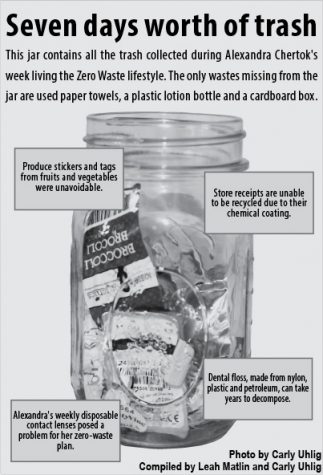I tried the Zero Waste lifestyle

As I routinely dried my hands with a brown paper towel from a school bathroom, I realized I had already made a mistake — and it had only been a few hours.
After being intrigued by pictures of a year of garbage fitting into one mason jar, I decided to try the Zero Waste lifestyle for seven days. This meant I would try to avoid using anything that came in packaging other than glass. Plastic is considered the worst kind of packaging, and recycling is seen as a last resort for this lifestyle. Cloth napkins are used to avoid waste from paper towels and napkins, and food scraps are composted. And yes, toilet paper is allowed.
Since I only did this challenge for a week and it would be impossible to replace everything in my house with a Zero Waste version, I decided to focus on eliminating garbage from food and toiletries.
On my first day, I went groceryshopping at Whole Foods Market and was pleasantly surprised with how easy it was to shop without plastic.I brought a canvas bag for fruits and vegetables, and the employees had no problem subtracting the weight of my jars when I purchased bulk grains and nuts. I generally don’t eat much processed food, so the food aspect wasn’t too difficult, although I did miss the convenience of prepackaged granola bars throughout the week.
I experienced less success with hygiene products. Although my homemade toothpaste which consisted of only coconut oil and baking soda was more effective than I had anticipated, my DIY shampoo was most definitely not. A simple recipe I found online claimed that those same ingredients plus apple cider vinegar would form an amazing, hair-softening shampoo. But after 10 minutes of skeptical mixing, I was left with a strange, lumpy concoction that took me 20 minutes to rinse out. I woke up the next morning to find bits of dried baking soda in my hair, and after three days, it looked and felt like hay straight out of a barn. I ended up wearing French braids for the rest of the week to avoid washing my hair.
At the end of my Zero Waste week, I realized that the baking soda and the bar of soap I was using had come from cardboard boxes. Since cardboard is recyclable and compostable, it would have less of an impact on the environment than shampoo from a plastic bottle, but packaging of any nature is supposed to be avoided with this movement. Perhaps people truly living a Zero Waste lifestyle would buy baking soda in bulk or find expensive refillable shampoo in a reusable bottle, but these products are not easily available and their costs make it clear that the Zero Waste lifestyle is not realistic for everyone.
Fruit stickers, contact lens packaging and dental floss filled my mason jar at the end of the week. However, this didn’t account for the few sheets of paper towels I had accidentally thrown out, the baking soda packaging I had used or the lotion I had mistakenly used from a big plastic bottle. The mason jars all over social media might be a great way to hook people into the movement, but from my experience, it was not an accurate indicator of how much waste I really produced.
That being said, there is definitely more we can do to reduce waste. While I don’t think producing absolutely zero waste is realistic, I have become more aware of how much I throw out and just how prevalent plastic, paper towels and other single-use items are in our package-filled world. I will continue to buy my produce in canvas bags and dry my hands with a reusable cloth, but I will happily use my glossy plastic-bottled shampoo.

